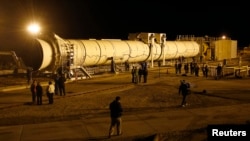A beefed-up space shuttle solid rocket motor passed a two-minute test-firing in Utah on Wednesday, a key milestone toward the debut flight of NASA's deep-space launcher in 2018, the U.S. space agency said.
Anchored horizontally to a test stand in the desert in Promontory, Utah, the five-segment motor, built by Orbital ATK, ignited at 9:30 am local time (1530 GMT).
Bright flames shot out the rear of the rocket for two minutes, marking the first full-duration burn of the enhanced solid-fuel shuttle booster rocket, a live NASA Television broadcast showed.
“It looked really clean. We're very excited. Great result,” said Charlie Precourt, an Orbital ATK vice president and former NASA astronaut.
The 177-foot (54-meter) motor is 25 percent more powerful than the four-segment engines used to help lift the space shuttle. The shuttles were retired in 2011 after 135 flights, two of which ended in disaster.
Several shuttle-era components are being incorporated into the new rocket program, known as the Space Launch System. The motor tested on Wednesday included hardware flown on the first shuttle mission in 1981, NASA spokeswoman Stephanie Schierholz said.
The test was the first of two planned before two boosters are paired with four liquid-fueled modified shuttle main engines and topped with an Orion capsule for an unmanned debut run around the moon in 2018. Orion, flying on top of a United Launch Alliance Delta 4 rocket, made its initial test flight in December.
United Launch Alliance is a partnership of Lockheed Martin and Boeing.
NASA is spending about $3 billion a year to develop the Space Launch System rocket and Orion capsule, which are designed to fly astronauts to asteroids, the moon, Mars and other destinations beyond the International Space Station's 260-mile (418 km)-high orbit.
Orbital ATK, a newly formed merger of Orbital Sciences and Alliant Techsystems' Aerospace and Defense Groups, has a second NASA contract to fly cargo to the station, a $100 billion project of 15 nations. The company is revamping its Antares rocket after a launch accident in October.
NASA: Enhanced Space Shuttle Solid Rocket Motor Passes Test-firing
- By Reuters

CAPE CANAVERAL, FLORIDA —







